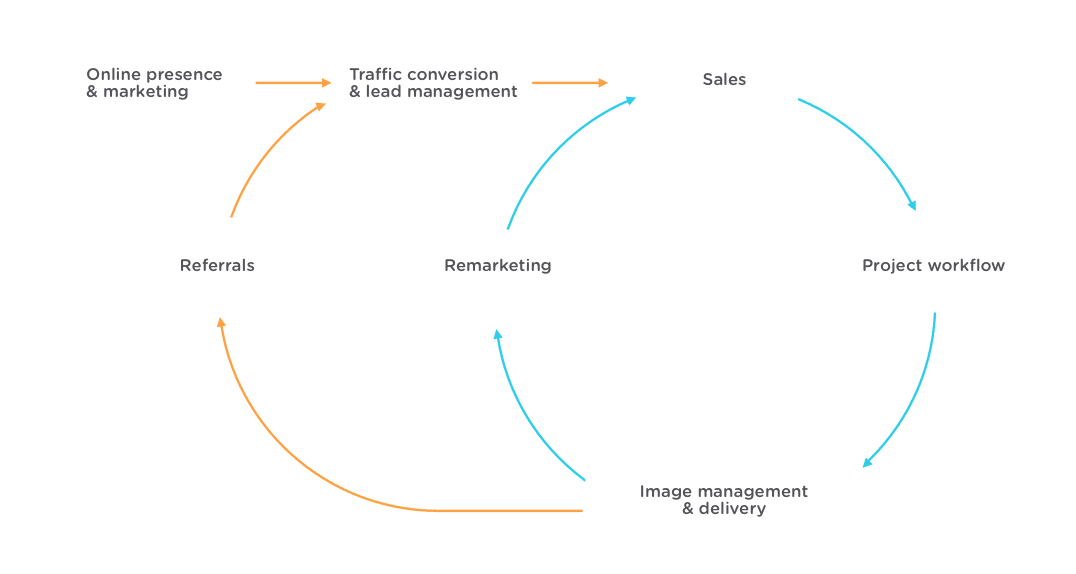Running a photography business is like trying to manage a cat farm. Keeping track of every prospect, client, and task is so daunting, it is no surprise that many photographers encounter a rude awakening when they take up photography full-time.
Furthermore, many photographers struggle to understand why exactly they aren’t booking more clients, and what could be done to grow their business. If you read online blogs, you will find wisdom that ranges from, “Just do good photography, and clients will find you” and the opposite, “it doesn’t matter how good your work is, if you don’t know how to market yourself you’ll be broke”. So which is it?
YES.
Assuming you do good photography, why aren’t you getting more clients? Do you know how to evaluate your photography business?
For most photographers, there is a predictable business cycle. The better you can grasp each component of this cycle, the more effectively you will know which area needs more attention.
At Picr, we have been thinking about how photographers manage their business for several years, and here is the cycle that we have come up with.

1. Online presence & marketing. In a digital age, aquiring new clients without an online presence is nearly impossible for any industry. This is why most photographers go through the hassle of building a website and an online portfolio. But the expected eureka of instant success is quickly shattered as the new website gathers dust with only an occasional visit from a friend you bribed. This is where marketing tools and skills are critical. Here are some methods to drive traffic to your website.
- Develop a good Instagram following by regularly posting and tagging your best images. Be sure to add your website URL and a CTA in your profile description. For example, “Contact me to book a session on www.smithphotography.com”
- Be sure to optimize your webpage for local SEO traffic. If possible, be sure to include your address and phone number in your footer and make sure that you are listed on Google as a local business.
- Regularly post good new content to your website which emphasizes important keywords. A good strategy is to run a blog on your website but make sure that your posts include a good amount of copy emphasizing highly rated keywords. An easy way to test keywords is to compare them on google.com/trends.
- Experiment with local Facebook or Google Ads. But you have to be careful because unless you run an ad correctly, it can be a complete waste of money.
If you play the marketing game correctly, you should be able to get traffic to your website. If you continue to struggle with this, consider taking a course or two on Lynda.com
2. Traffic Conversion and Lead Management. Once you have some web traffic, the next challenge is conversion and lead management. In our experience, this is where many photographers flop and build their websites as an artistic portfolio rather than a place to convert traffic into leads. There is a science behind writing copy and positioning CTAs to optimize conversion which remains untapped by most photographers, who expect an uninspiring WordPress contact form to do all of the heavy lifting (assuming it’s not broken due to a WordPress update). But you can’t expect a high conversion rate from that.
When someone stumbles upon your website, don’t expect to get a sale right away, you have to be patient. Most people visiting your page are curious but aren’t ready to buy. Your goal is to convert them into leads—which will require capturing their basic information (at minimum a name and email). If you ask for too much information, then you decrease the chances that your visitors give you anything. There are many plugins you can use on WordPress, like SumoMe and Optin Froms. But this can get expensive and difficult to manage, which is why we are building a website experience for you at Picr that includes all of the tools you need to capture and manage leads.
Here are some important questions to ask yourself.
- Are you capturing leads? How?
- Do you know your conversion rate? How many of your unique visitors are becoming leads?
- What are you doing with your leads to convert them? What is your sales funnel?

3. Sales. Once you have a list of leads (usually emails and phone numbers), you need a good strategy for how you will sell your service to them. Most photographers don’t like direct sales and fortunately, sales doesn’t mean awkward emails to your contacts asking for money. You need to understand who your leads are and develop a good strategy for how you will turn them into paying clients. Here are some standard practices:
- Segment your leads. Don’t try to sell portrait photography to leads who are interested in your commercial work. You can segment your leads when you are capturing them, or send them followup emails and find creative ways to discover their interests. You can also segment based on location, gender, age, etc.
- Send targeted emails. Once you have segmented your leads, don’t be afraid to send them good service offers which are enticing and irresistible. Run campaigns and promotions which they simply cannot resist.
- Track your conversion rates, and optimize your emails with every iteration.
4. Project Workflow. Once you have converted your lead into a client, the euphoria of receiving a deposit in your bank account is soon dismantled by the challenges related to managing several projects at once. From our research, we have found that all online tools fall short of giving photographers a good workflow management. As a result, many photographers resort to using a whiteboard. But this is also imperfect because every specialty requires a different workflow.

5. Image Management & Delivery. Once you have taken and processed your client’s images, you have the product. Since these files are typically quite large, image management and delivery is not as easy as it sounds. Consider the following:
- Make sure that you have good internet speed. You can test your speed using this service for free. If you’re using your computer wirelessly, consider the distance from your router. It can significantly decrease your internet speed. In the end, your time is more valuable than what you will save on your internet bill.
- Store your images in the cloud. Server space is becoming more and more affordable, and storing your images on a Dropbox, Apple, Microsoft, or Amazon server is far more secure than any hard drive at home. Additionally, this gives you remote access to your files in case you’re traveling, and if something does happen to their servers, your clients will be more understanding than if your personal hard drive failed.
- Make sure have a presentable delivery. Part of the photography experience is how the final product arrives. If the client ordered prints, make sure that they are delivered in a presentable way. Think of how Apple packages their products. If your client ordered digitals, be sure to use an online service that has a presentable delivery page. Unfortunately, Dropbox was not designed for this. If you’re just giving your clients a dropbox link or a thumb-drive, don’t expect them to be impressed with the delivery. Once again, we have placed a high value on the client experience at Picr and are building a client portal that you can be proud of aesthetically and functionally.
6. Re-marketing. This is another huge opportunity which many photographers fail to take advantage of. Statistically, if a client has purchased from you, they are 60-80% more likely to book again than. These are your best leads and you must have a good strategy to re-market to them. Here are some ideas:
- Collect important data from them during your photoshoot. Like their birthday, anniversary, if they have children, where they work, etc.
- Segment your clients just like do with leads.
- Create automated emails and/or texts to sell your services to them and get them to book again.
- Consider running special promotions just for previous clients. Make them feel special and they will love you back.
7. Referrals. Finally, the nature of photography is such, that the best way to get new clients is through word of mouth. While most photographers know this very well, not many maximize this opportunity.
- Consider developing a referral program, where you give your clients an incentive in exchange for referrals. This could be anything from prints, to free sessions.
- Make sure that when you deliver your images, it is easy to share them. This is where anyone using Dropbox or a Thumb-drive completely misses out. You need to deliver the images in such a way that the client can share them with the click of a button. The less resistance, the better the results.
- Don’t be shy to ask your clients to recommend you to their friends.
Much more could be said and nuanced in this business cycle. Take a moment to evaluate your photography business in each of these 7 areas and give yourself a 1-10 score. How good are you doing in each of these? Running your own photography business is certainly not easy, but if you could learn basic skills in each of these disciplines, you will be miles ahead of everyone else.
At Picr, we want to make sure that your photography business is successful, which is why we are building a robust toolset which will allow you to manage each of these components in one centralized place. Subscribe to receive important updates on the development and launch of Picr Beta in the spring of 2017!